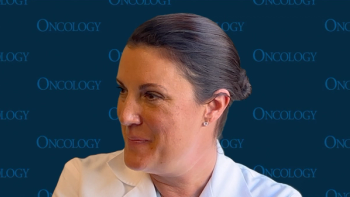
Analyzing Trials and Treatments in HER2+ Breast Cancer
Experts discuss various treatment options for patients with HER2-positive breast cancer, and which would benefit the most based on their characteristics.
With the advent of multiple treatment options for patients with HER2-positive breast cancer, determining a specific regimen may be difficult. While treatments from trials like the phase 3 HER2CLIMB-05 (NCT05132582) trial, DESTINY-Breast03 trial (NCT03529110) or DESTINY-Breast09 trial (NCT04784715), and CLEOPATRA trial (NCT00567190) offer survival benefits, determining which of these will offer the most for patients remains a challenge.1-4
In an Around the Practice discussion, clinicians gathered to break down each of these trials, when they use these specific regimens, and how they determine the right one for their patients. The efficacy and safety of treatments like trastuzumab deruxtecan (T-DXd; Enhertu), tucatinib (Tukysa), pertuzumab (Perjeta), and palbociclib (Ibrance) were highlighted.
The panel was led by VK Gadi, MD, PhD, deputy director of the University of Illinois Cancer Center, and a professor and director of Medical Oncology at the University of Illinois Chicago. He was joined by Heather McArthur, MD, clinical director of Breast Cancer and Komen Distinguished Chair in Clinical Breast Cancer Research at the University of Texas Southwestern Medical Center; Ruta Rao, MD, professor in the Department of Internal Medicine, director of the Coleman Foundation Comprehensive Breast Cancer Clinic, and medical director of Rush University Cancer Center; and Gregory Vidal, MD, PhD, a medical oncologist at West Cancer Center and Regional One Health.
What is The Background of The HER2-Positive Setting?
Gadi: Because it’s been [a bit] since the 2024 San Antonio [Breast Cancer Symposium], have you, in the estrogen receptor [ER]–positive and triple-positive [setting], been using CDK4/6 inhibitors as part of the phase 3 PATINA trial [NCT02947685] regimen?5
Vidal: I have not yet had the opportunity to do it. That doesn’t mean that I wouldn’t do it. The question becomes, for the patients whom I now have on maintenance therapy, on [aromatase inhibitors], do I then add palbociclib? That’s what we’re trying to figure out. Some institutions have, if they’re within the 12 months, added the palbociclib to it. I haven’t yet had that opportunity, but certainly the data were very convincing for the benefit.
McArthur: I was giving [the PATINA regimen] the day after San Antonio. Let’s level set here, because it is the foundation for any discussion about DESTINY-Breast09, which is one of the big take-home messages from the 2025 American Society of Clinical Oncology Annual Meeting: an essentially 15-month improvement in progression-free survival [PFS] with the addition of palbociclib to maintenance endocrine therapy in our population. That is a huge, unprecedented improvement. Palbociclib is very well tolerated and doesn’t add to toxicity. At our site, we started prescribing it the next day. I’d say it’s about 50/50, where we get payer approval for palbociclib in that setting. We’ve been working with partners to try to get access for all our patients, so it’s not ubiquitously available.
Vidal: Are you doing it for everyone on maintenance now? How do you decide?
McArthur: For patients with ER-positive disease who have a good response to induction, I treat for the full 6 months with docetaxel, trastuzumab [Herceptin], and pertuzumab [Perjeta; THP] up front before I transition to a maintenance therapy. Probably most patients who have triple-positive disease have a good response to induction chemotherapy.
Gadi: We talked about induction, and that induction strategy may change soon, but once you finish the chemotherapy, maybe walk us through in your discussion around [maintenance].
Vidal: The CLEOPATRA trial of THP set that standard for us, and it’s an easy discussion to say for patients that “your tumor is aggressive enough that it needs some chemotherapy to get some control, but we can give you a chemotherapy break because your [disease] is incurable and you would need to have some control for a very long time, essentially for the rest of your life.” The transition after about 6 to 8 cycles, for me, is also the best response. Sometimes, we transition to just [antibody drug conjugates], which are very well tolerated by patients. I have patients who’ve been on this [regimen] for 8 years and continue to show no evidence of disease or very good control of disease. For the patients who have ER-positive [disease], we add anti-estrogen therapy to that backbone; that’s how we go through this transition.
Gadi: What is the best response?
Vidal: In my mind, this type of disease loves to go to the visceral organs. For a patient with a high burden of, say, liver disease, I will give chemotherapy until I can see that there’s a plateau of response in the liver, on imaging. Circulating tumor DNA [ctDNA] has the potential to help here, but we don’t have enough data to be able to utilize that.
Gadi: Have you used ctDNA to find the best response when it plateaus, or is it just imaging? What’s your practice?
Rao: I use imaging to define the best response. I am starting to use a little bit of ctDNA, almost in the setting of a tumor marker. As I follow some of my patients, especially the women who are doing well on maintenance [antibody drug conjugates], sometimes, I’m using the ctDNA as a tumor marker to get an idea of where we are in terms of their disease control.
McArthur: I never use ctDNA because I don’t feel that we understand how to best use that technology in any breast cancer setting yet. I use imaging with tumor markers—and there’s a lot of patient education—because the tumor markers almost always get worse before they get better. I have to explain to them that it trends over time, together with clinical information and radiographic information, every 3 months.
How Have Updates in Clinical Trials Changed the HER2 Landscape?
Gadi: Let’s talk about some new studies; one is more speculative. We’ll start with the HER2CLIMB-05 trial. Heather, maybe you can walk us through that.
McArthur: HER2CLIMB-05 is a global randomized phase 3 study that’s looking at tucatinib together with trastuzumab and pertuzumab. It is very similar to the PATINA regimen, but without the CDK4/6 inhibitor; here, a TKI [is used] instead. Patients who have ER-positive disease can receive endocrine therapy. That’s a study that’s ongoing, and those data are anticipated, although, again, I would say that PATINA set the bar very high.
Gadi: Is the concern about brain metastases influencing your [treatment] decision? We don’t think about palbociclib as a good brain metastasis drug.
McArthur: Currently, I don’t screen for brain metastases at metastatic diagnosis, so I don’t see that influencing my decision-making up front. We have a low threshold for screening for brain metastases later in disease, and that certainly influences our decisions about T-DXd or the HER2CLIMB regimen, but I don’t see that influencing upfront decision-making because I’m not looking for that problem yet.
Gadi: Do you see HER2CLIMB-05 changing things for you?
Rao: It will give us something to do in the maintenance setting, especially in patients with ER-positive tumors, because we have PATINA to use in triple-positive [disease]. The other thing that will be important to see is what it does to the development of brain metastases and if it delays the development of new brain metastases. We know that the central nervous system [CNS] is an unfortunate site of failure for many of our patients, especially when they even have excellent systemic control. That may push us to use it for more patients, and that would be a nice thing: to delay that CNS development.
Gadi: Let’s talk about the current standard regarding where we position T-DXd, primarily [based on] the DESTINY-Breast03 trial.
Rao: DESTINY-Breast03 established T-DXd as our preferred second-line treatment option. If you remember, this was a trial that compared T-DXd with T-DM1 [trastuzumab emtansine; Kadcyla] in the second-line setting for patients who had been previously treated with a taxane and trastuzumab. We saw a significant improvement in median PFS at 29.0 months [with T-DXd] vs 7.2 months [with T-DM1]. This was one where those curves were so separate. It was one of the most impressive HRs we’ve seen in breast cancer. We all have that image in our mind, so that firmly established [T-DXd] in the second-line setting. We also saw an overall survival [OS] improvement with T-DXd.
Gadi: Have you noticed that providers in the community are using that drug in the second line? It’s gotten rapid uptake.
McArthur: T-DM1 is a good drug. But in this rapidly evolving landscape, where does it fit in from an algorithm perspective? It’s getting lost in the third line, fourth line, and beyond, with all the other options that we have for HER2-positive diseases.
Gadi: What are your impressions of DESTINY-Breast09?
Vidal: DESTINY-Breast09 was a study that randomly assigned patients who were in the first-line metastatic [setting] who had at least a disease-free interval of 6 months or were HER2 positive. You could be ER positive or negative in 1 of 3 arms: one that is standard of care, the CLEOPATRA regimen, which we’ve been talking about; the T-DXd only arm; or the T-DXd plus pertuzumab arm. What we saw in this interim analysis was the T-DXd plus pertuzumab vs the standard of care. There were not enough events yet in the T-DXd [monotherapy] arm, but we’re waiting for that.
What that showed was an improvement in median PFS, which was the primary end point, from 26.9 months [with THP] to 40.7 months [with T-DXd plus pertuzumab], which was highly statistically significant; the curve separated very early. Even more importantly, when you go to PFS2—which, again, is early—we do see, again, a separation of the curve. There’s an HR of 0.60 (95% CI, 0.45-0.79; P = .00038), and it’s our early view into what OS may look like.
The problem with the study is, as far as the patients recruited for the study, whether they truly represent the patients we see here in the US. For one, about 50% of those patients had de novo [disease]. Only about 20% had received prior trastuzumab, and less than 10% had received prior pertuzumab. Even if you just take the patients without de novo [disease] in the US, I’m assuming nearly 100% would have gotten prior trastuzumab or pertuzumab.
There’s a question here with the applicability. Even with PFS2, when we look at what those patients have gotten on progression, again, there was very low use of T-DXd, but it may represent where the study was conducted and whether or not those drugs were available for use as standard of care. Overall, [treatment was] well tolerated and excellent. This curve separated; almost a 14% or 15% difference in PFS….The partial response rate was about 70% [with T-DXd plus pertuzumab]. There was about a doubling in complete responses from about 8.5% to 15.1% [with THP vs T-DXd plus pertuzumab]. We need to see who is in that 15.1% to give us a better idea of who’s getting a CR. [Regarding] the median duration of response, if you got the T-DXd plus pertuzumab, you were on the drug for longer periods, and it mirrored what we saw in about 39.2 months vs about 26.4 months.
Gadi: Heather, could you walk us through what your impressions were of the tolerability?
McArthur: The recent DESTINY-Breast studies, in aggregate, have identified the issue of interstitial lung disease [ILD], pneumonitis, and potentially fatal ILD pneumonitis. In the recent DESTINY-Breast studies, scans were done frequently. They were done every 6 months on the study. In response to DESTINY-Breast06 [NCT04494425] and DESTINY-Breast04 [NCT03734029], I’ve changed my own practice. Typically, I would do scans routinely every 12 weeks, or thereabouts. I can’t do them every 6 weeks; patients won’t accept that, and payers won’t accept that. I’m splitting the difference and looking at every 9 weeks. What’s interesting to me is that despite the heightened awareness around potentially fatal pneumonitis and ILD, they did have 2 deaths on DESTINY-Breast09 that were attributed to ILD. Despite that vigilance, it’s a real problem.
Gadi: Before we close here on this awesome discussion, there’s a trial and a manuscript published in Nature Medicine.6 Tell us a little bit about the phase 3b/4 DESTINY-Breast12 trial [NCT04739761] and how that frames our discussion around CNS treatment now, when we also have tucatinib.
Rao: We know that brain metastases are a significant unmet need in this patient population. For HER2-positive metastatic breast cancer, HER2CLIMB was the first trial that allowed patients to enroll with active, stable, untreated, progressing brain metastases. We were all very impressed by the percentage of patients with brain metastases who enrolled on that trial. We saw great responses in that population in terms of PFS, as well as a lot of the CNS parameters. We got a hint that T-DXd also had CNS activity when they did the pooled analysis of the DESTINY-Breast trials. At the European Society of Medical Oncology Congress 2024, we saw DESTINY-Breast12, which was a phase 3b/4 study looking at T-DXd in patients with and without brain metastasis, and we saw some impressive results. There was a 12-month PFS of 61.6%, and the intracranial response rate was 71.7% for those patients. The bottom line is we now have 2 drugs that are very active in the CNS for these patients.
Gadi: It challenges a dogma that many of us parroted, which is that big, bulky drugs don’t get across the CNS. What’s relevant here is that it’s a blood-brain metastasis barrier, not a blood-brain barrier.
McArthur: We should applaud the HER2CLIMB team; they were bold. Patients with active brain metastases had never been [studied] before, and it set a new bar for this space of unmet need, which is terrific.
Rao: The multidisciplinary approach is very important. We keep talking about it with our multidisciplinary teams. Sometimes, with these small, asymptomatic brain metastases, the radiation oncologist will call and say, “Is there something that you can do for these patients who are HER2 positive?” It will get there. We just have to continue to educate our colleagues that we have these treatments.
References
- Hamilton E, Diéras V, Tsurutani J, et al. Abstract PO1-19-11: Phase 3 study of tucatinib or placebo in combination with trastuzumab and pertuzumab as maintenance therapy for HER2+ metastatic breast cancer (HER2CLIMB-05, trial in progress). Cancer Res. 2024;84(suppl 9:PO1-19-11. doi:10.1158/1538-7445.SABCS23-PO1-19-11
- Hamilton EP, Hurvitz SA, Im SA, et al. Trastuzumab deruxtecan (T-DXd) vs trastuzumab emtansine (T-DM1) in patients (pts) with HER2+ metastatic breast cancer (mBC): Updated survival results of DESTINY-Breast03. J Clin Oncol. 2024; 42(suppl 16):1025. doi:10.1200/JCO.2024.42.16_suppl.1025
- Tolaney S, Jiang Z, Zhang Q, et al. Trastuzumab deruxtecan (T-DXd) + pertuzumab (P) vs taxane + trastuzumab + pertuzumab (THP) for first-line (1L) treatment of patients (pts) with human epidermal growth factor receptor 2–positive (HER2+) advanced/metastatic breast cancer (a/mBC): interim results from DESTINY-Breast09. J Clin Oncol. 2025;43(suppl 17):1008. doi:10.1200/JCO.2025.43.17_suppl.LBA1008
- Swain SM, Miles D, Kim SB, et al. Pertuzumab, trastuzumab, and docetaxel for HER2-positive metastatic breast cancer (CLEOPATRA): end-of-study results from a double-blind, randomised, placebo-controlled, phase 3 study. Lancet Oncol. 2020;21(4):519-530. doi:10.1016/S1470-2045(19)30863-0
- Metzger O, Mandrekar S, DeMichele A, et al. AFT-38 PATINA: a randomized, open label, phase III trial to evaluate the efficacy and safety of palbociclib + anti-HER2 therapy + endocrine therapy vs. anti-HER2 therapy + endocrine therapy after induction treatment for hormone receptor-positive (HR+)/HER2-positive metastatic breast cancer. Presented at the 2024 San Antonio Breast Cancer Symposium; December 10-13, 2024; San Antonio, TX.
- Harbeck N, Ciruelos E, Jerusalem G, et al. Trastuzumab deruxtecan in HER2-positive advanced breast cancer with or without brain metastases: a phase 3b/4 trial. Nat Med. 2024;30(12):3717-3727. doi:10.1038/s41591-024-03261-7
Newsletter
Stay up to date on recent advances in the multidisciplinary approach to cancer.

















































































